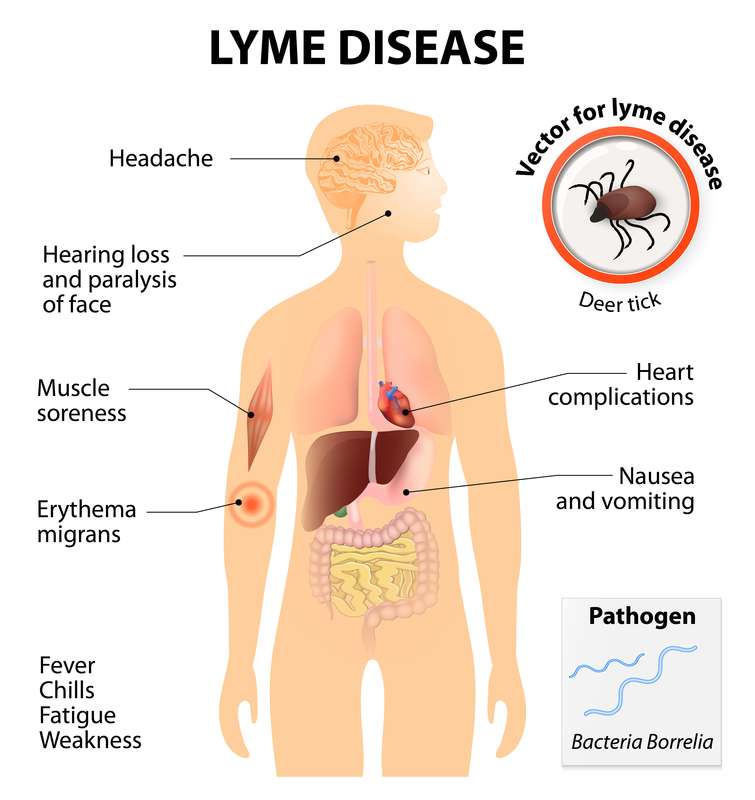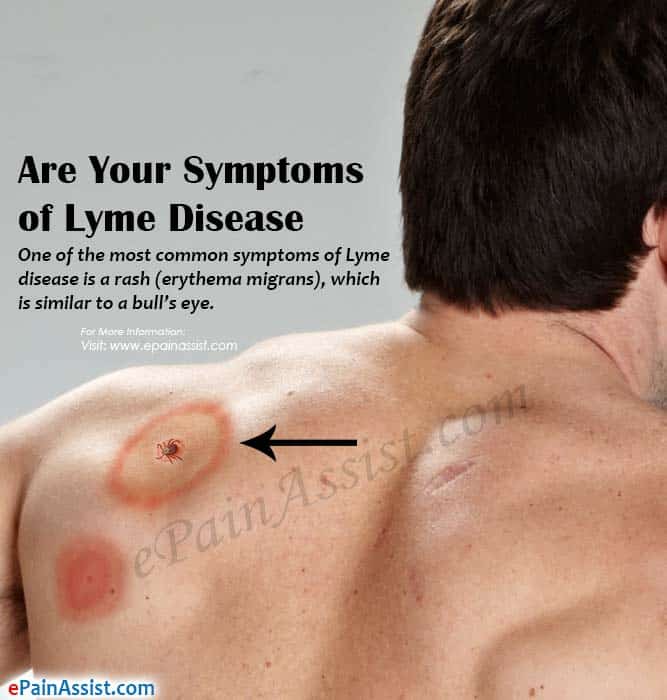What Happens If Lyme Disease Goes Untreated For Years
If Lyme disease goes untreated for years, youll suffer its long-term effects, which include chronic joint inflammation, heart problems , psychological disorders, sleep problems, memory loss, and nerve damage. Moreover, since Lyme disease has a multisystemic impact, it is highly likely to infect several organs.
The Numbers On Chronic Lyme
Because Lyme disease is commonly missed or misdiagnosed, statistics vary on how many Lyme patients go on to experience chronic symptoms. The following research nonetheless paints a basic picture of the problem.
- An estimated 5-20% of patients may have chronic symptoms after getting Lyme disease, according to the Columbia University Irving Medical Center.
- The treatment failure rate for chronic Lyme disease patients was estimated at 26-50% in 2004, compared to 16-39% for early Lyme patients, according to Lymedisease.org.
- Up to 15-40% of late-stage Lyme patients develop neurological disorders, which are responsible for many common symptoms of chronic Lyme disease.
Experts dont know for sure why some people experience persistent symptoms, even with treatment. However, some believe the Lyme infection may trigger an auto-immune response that manifests in the chronic symptoms detailed below.
Chronic Lyme Disease Symptom Severity
In LDos chronic Lyme disease survey, over 75% of patients reported at least one symptom as severe or very severe and 63% reported two or more such symptoms. Find out more about LDo peer-reviewed published surveys. The chart below shows the severity of ten common chronic Lyme symptoms.
The survey also found that patients with chronic Lyme disease have high disability and unemployment rates. Over 40% of patients with chronic Lyme disease reported that they currently are unable to work because of Lyme disease and 24% report that they have received disability at some point in their illness.
Read Also: How To Know If A Tick Carries Lyme Disease
When To See A Healthcare Provider
Since Lyme disease can take different forms, and since its often confused with other conditions, its important to be proactive if you suspect the condition. What signs prompt medical help? Call the healthcare provider if:
- You have a bullseye rashor any kind of rashfollowing a tick bite.
- You experience flu-like symptoms after a tick bite.
- You experience symptoms of more advanced Lyme disease: arthritis, heart palpitations, facial paralysis, dizziness, and others.
Symptoms Of Post Treatment Lyme Disease

- Include severe fatigue, musculoskeletal pain, & cognitive problems
- Can significantly impact patients health and quality of life
- Can be debilitating and prolonged
Our research indicates the chronic symptom burden related to PTLD is significant. Although often invisible to others, the negative impact on quality of life and daily functioning is substantial for PTLD sufferers.
The chronic symptom burden related to Lyme disease is considerable, as shown on the left side of the graph above, and statistically significantly greater than the aches and pains of daily living experienced by the control group, on the right.
Read Also: How Long After A Tick Bite Lyme Disease
How To Protect Your Property And Your Pets
On this last topic, Bloom commented that the majority of flea and tick control medicines on the market work fairly well. He, however, cautioned against using more than one of them in tandem.
In my opinion, it would be overly cautious to use more than one, he says. In other words, I wouldnt use both a collar and a topical prevention, or an oral preventionand a topical. I think thats kind of too much poison for the dog.
You can, however, combine one of the topical or oral preventatives with the Lyme vaccine. So there is a way you can further protect your pet from contracting the disease if you live in an area where deer are prevalent.
If youre looking for an additional way to protect your yard, Bloom recommends having the perimeter sprayed by a pest control company.
Goldstein also recommended treating the perimeter of your property, but his recommendation came in the form of a physical barrier, rather than one of pesticides.
If youre up against woods in your yard, a barrier of wood chips of pebbles will prevent at least the ticks from going across, explains Goldstein. They can be carried across it by an animal, but at least they wont cross a barrier like that.
Who’s At Risk Of Lyme Disease
The risk of getting Lyme disease is higher:
- for people who spend time in woodland or moorland areas
- from March to October because more people take part in outdoor activities
It’s thought only a small proportion of ticks carry the bacteria that cause Lyme disease. Being bitten doesn’t mean you’ll definitely be infected. However, it’s important to be aware of the risk and speak to a GP if you start to feel unwell.
Also Check: Is Lyme Disease A Bacterial Infection
Can Lyme Disease Cause Problems Later In Life
If Lyme disease is not diagnosed and treated early, the spirochetes can spread and may go into hiding in different parts of the body. Weeks, months or even years later, patients may develop problems with the brain and nervous system, muscles and joints, heart and circulation, digestion, reproductive system, and skin.
Can Lyme Disease Be Prevented
To prevent Lyme disease, you should lower your risk of getting a tick bite:
- Avoid areas where ticks live, such as grassy, brushy, or wooded areas. If you are hiking, walk in the center of the trail to avoid brush and grass.
- Use an insect repellent with DEET
- Treat your clothing and gear with a repellant containing 0.5% permethrin
- Wear light-colored protective clothing, so you can easily see any ticks that get on you
- Wear a long-sleeve shirt and long pants. Also tuck your shirt into your pants and your pant legs into your socks.
- Check yourself, your children, and your pets daily for ticks. Carefully remove any ticks you find.
- Take a shower and wash and dry your clothes at high temperatures after being outdoors
Centers for Disease Control and Prevention
Recommended Reading: Grants For Lyme Disease Patients
How Is Lyme Disease Treated
Your healthcare provider will figure out the best treatment for you based on:
-
How old you are
Lyme disease in the earliest stage is usually treated with antibiotics for 2 to 3 weeks.
Treatment will also be considered based on these and other factors:
-
If you are bitten by a tick that tests positive for the bacteria that causes Lyme disease
-
If you are bitten by a tick and have any of the symptoms
-
If you are bitten by a tick and are pregnant
-
If you are bitten by a tick and live in a high-risk area
Read Also: Can Lyme Disease Cause Headaches
The Signs And Symptoms Of Untreated Lyme Disease
3 Minute Read
With the growing awareness of Lyme disease, many worry they have the illness. To contract Lyme, a blacklegged tick must attach to you for roughly 1 to 2 days. Thats how long it typically takes for the bacteria that causes Lyme disease to transfer into your blood.
However, not everyone who develops Lyme remembers a tick bite. Ticks are so small and can latch in hidden areas like the scalp or groin. And tick bites are most often painless.
So how would you know if you have Lyme disease? The signs and symptoms tend to follow a clear pattern.
Within a few days to one month after the tick bite, most people start to develop symptoms. If you dont recall a bite, you might trace your symptoms to when you went camping or hiking.
You May Like: Letsgetchecked At Home Lyme Disease Test
What Might A Doctor Misdiagnose Lyme Disease As
Ticks can carry a variety of different organisms and diseases with them.
The lone star tick can carry a disease known as southern tick-associated rash illness. The rash it causes to a Lyme disease rash. In addition, it can cause similar symptoms to Lyme disease, including fever, fatigue, joint and muscle aches, and headache.
What Are The Long Term Effects Of Lyme Disease

The long-term effects of Lyme disease, if untreated or inadequately treated, can vary from arthritis to severe neuropathy. Impaired memory can be seen in some cases and even heart is affected in some others. It is a disease which can cause serious long term effects if untreated or improperly treated.
There are some factors which can increase the risk of getting the Lyme disease. If one spends a lot of time in woods or grasslands, it creates a risk factor for Lyme disease, as ticks dwell more in this type of areas. Also, ticks get attached easily to the bare flesh. Hence, it is advisable to wear full clothing while going to a ticks-infested place. Also, protect your pets from ticks by keeping them away from grass and tall plants. If at all you see a tick on the body, it should be removed promptly and properly. If the tick stays on the body attached for more than 36 hours, it is likely to cause infection. Ticks being attached for less than that period usually do not cause infection.
Lyme disease may affect multiple organs and systems in our body. And hence, it is responsible for producing a wide range of symptoms, which are related to the affected organs. The incubation period for the bacteria may range from one to two weeks, from infection to symptom onset.
Read Also: How To Overcome Lyme Disease
Has Niaid Looked At Whether Infection Persists After Antibiotic Therapy
Several recent studies suggest that B. burgdorferi may persist in animals after antibiotic therapy. In one study, NIAID-supported scientists found that remnants of B. burgdorferi remained in mice after antibiotic treatment. Another team of NIAID-supported investigators found that intact B. burgdorferi persist in nonhuman primates after antibiotic treatment. It was not possible to culture these bacteria and it is not clear whether they are infectious. More recent work by Hodzic et al. replicated the earlier finding of persisting DNA but non-cultivatable B. burgdorferi after antibiotic treatment using a mouse model. In 2017, scientists at the Tulane National Primate Research Centers, funded in part by an NIH research resources grant, reported evidence of persistent and metabolically active B. burgdorferi after antibiotic treatment in rhesus macaques.
In a first-of-its-kind study for Lyme disease, NIAID-supported researchers have used live, disease-free ticks to see if Lyme disease bacteria can be detected in people who continue to experience symptoms such as fatigue or arthritis after completing antibiotic therapy). This study remains underway.
Which Organs Are Affected By Lyme Disease
The organs affected by Lyme varydepending on the severity of the illness and how early it is caught andtreated. In the early stages, the disease attacks mostly the immune system,compromising its ability to fight off the infection. As the disease spreads, itdoes so throughout the entire body, affecting every organ it reaches.
As Lyme can affect all the organs in thebody, it can cause a variety of problems. The symptoms that occur with Lyme diseasecan also mimic other conditions, like the flu as mentioned above, or moreserious conditions such as ALS/MND , MS , fibromyalgia, Parkinsons, Alzheimers, and over 300 otherconditions.
Image by on : The spread of Lyme disease bacteria cells works a lot like the cells of the immune response.
Recommended Reading: What Does Lyme Disease Affect
When Lyme Disease Never Ends: Post Treatment Lyme Disease Syndrome
Summer is officially here!
Do you have your outdoor activities checklist ready yet? Dont forget to add Stay-away-from-ticks to this list.
Lyme disease, caused by the bacteria Borrelia Burgdorferi from tick bites is a chronic condition characterized by an initial bullseye rash. The bacterial invasion hijacks the immune system resulting in susceptibility to co-infections, loss of cognitive function, and repeated reappearance of flu-like symptoms. Over time, many Lyme patients experience a worsening health curve.
An even uglier truth is post-treatment Lyme disease syndrome , a mysterious condition where chronic symptoms persist long after flushing out the pathogen from the body. The reason for recurring Lyme symptoms is not yet fully understood by the medical industry.
Today we are bringing PTLDS into the limelight to look at
- What is post-treatment Lyme disease syndrome ?
- How is it different from acute Lyme infection?
- Why do symptoms persist?
- How can Lyme disease be fully healed?
Lets take a closer look.
Also Check: How Do You Get A Tick Tested For Lyme Disease
Study Shows Evidence Of Severe And Lingering Symptoms In Some After Treatment For Lyme Disease
In a study of 61 people treated for the bacteria that causes Lyme disease, Johns Hopkins researchers conclude that fatigue…
In a study of 61 people treated for the bacteria that causes Lyme disease, Johns Hopkins researchers conclude that fatigue, pain, insomnia and depression do indeed persist over long periods of time for some people, despite largely normal physical exams and clinical laboratory testing.
Post-treatment Lyme disease syndrome is a real disorder that causes severe symptoms in the absence of clinically detectable infection, says John N. Aucott, M.D., associate professor of medicine at the Johns Hopkins University School of Medicine and director of the Johns Hopkins Lyme Disease Clinical Research Center.
The findings, published in the December issue of Frontiers in Medicine, could spur further investigation into the cause of persistent symptoms, a source of medical controversy. As Lyme disease rates have steadily climbed in the United States since it was first recognized in the mid-1970s, so have reports of a collection of symptoms that patients commonly refer to as chronic Lyme disease. Experts in the field have questioned the validity of this term because of the lack of direct evidence in this group of patients of ongoing infection with Borrelia burgdorferi, the bacterium that causes Lyme disease.
Other Johns Hopkins researchers who participated in this study include Alison W. Rebman, Ting Yang, Erica A. Mihm, Mark J. Soloski and Cheryl Novak.
Don’t Miss: What Bug Causes Lyme Disease
Who Is At Risk For Lyme Disease
Anyone can get a tick bite. But people who spend lots of time outdoors in wooded, grassy areas are at a higher risk. This includes campers, hikers, and people who work in gardens and parks.
Most tick bites happen in the summer months when ticks are most active and people spend more time outdoors. But you can get bitten in the warmer months of early fall, or even late winter if temperatures are unusually high. And if there is a mild winter, ticks may come out earlier than usual.
Read Also: Apartments For Rent In East Lyme Ct
Can You Live With Lyme Disease And Not Know It
One of the only reliable ways to know whether or not you have Lyme disease is through a lab test. This means that if symptoms go unnoticed, it is possible to live with the disease for weeks, months, or even years and not realize it. This is why its crucial to get tested if you suspect you could have contracted Lyme disease.
LetsGetCheckeds at-home Lyme Disease Test can identify Borrelia antibodies in the blood, which can indicate the presence of Lyme disease . Online results will be available within 2-5 days and our dedicated clinical team will be available to help throughout the process to answer any questions you may have.
You should consider taking the test if:
- You are presenting with symptoms of Lyme disease
- You live in a place that is rich in vegetation or a woodland area
- You live in Northern America or Northern Europe
- You go camping or hiking on a regular basis, particularly during the Summer or Autumn
- You come into contact with larger woodland animals on a regular basis
If you develop the erythema migrans rash, or if you experience any neurological symptoms, you should contact your doctor immediately.
Also Check: Prophylactic Treatment For Lyme Disease
Diagnosis Of Lyme Disease In Dogs
Because Lyme disease may not cause any obvious clinical signs but can still be fatal, its important to test your dog every year for Lyme disease if you live in an endemic area, and 4-6 weeks after a known tick bite . Most testing is done based on clinical signs or history.
In the clinic, your vet will test for the presence of antibodies to the Borrelia burgdorferi bacteria. This is just a quick positive-or-negative snap test. If the result is positive, this means antibodies are present, and your vet may send a more specific test to the lab to determine the approximate number of antibodies. A high number indicates an active infection is likely, whereas a low number may indicate that your dog was previously exposed . Some dogs may retain antibodies to tick-borne bacteria for several years after being exposed.
How You Get Lyme Disease

If a tick bites an animal carrying the bacteria that cause Lyme disease, the tick can become infected. The tick can then transfer the bacteria to a human by biting them.
Ticks dont jump or fly. They climb on to your clothes or skin if you brush against something theyre on. They then bite into the skin and start to feed on your blood.
Generally, youre more likely to become infected if the tick is attached to your skin for more than 24 hours. Ticks are very small and their bites are not painful, so you may not realise you have one attached to your skin.
Recommended Reading: Scotts Apple Orchard East Lyme Ct
What Are The Causes Of Migratory Arthritis
Migratory arthritis is an uncommon condition where arthritis symptoms travel from one joint to another. Symptoms can include pain, swelling, redness, warmth and stiffness. In most cases, the cause of migratory arthritis is an underlying medical condition. Keeping track of any symptoms that are occurring, along with what makes them better and what makes them worse, can help in the diagnostic process.